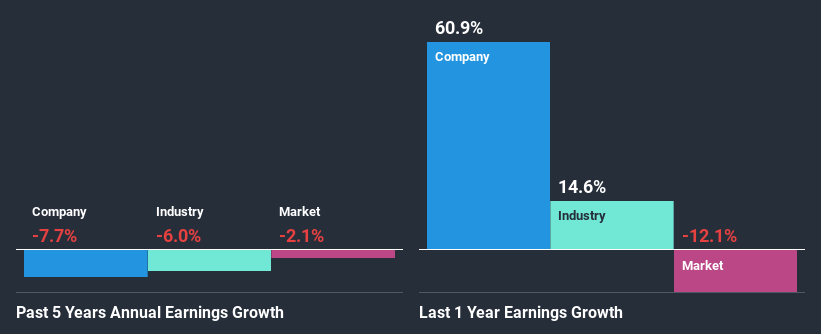Kim Loong Resources Berhad's (KLSE:KMLOONG) Financials Are Too Obscure To Link With Current Share Price Momentum: What's In Store For the Stock?
Most readers would already be aware that Kim Loong Resources Berhad's (KLSE:KMLOONG) stock increased significantly by 14% over the past three months. But the company's key financial indicators appear to be differing across the board and that makes us question whether or not the company's current share price momentum can be maintained. In this article, we decided to focus on Kim Loong Resources Berhad's ROE.
Return on Equity or ROE is a test of how effectively a company is growing its value and managing investors’ money. In other words, it is a profitability ratio which measures the rate of return on the capital provided by the company's shareholders.
See our latest analysis for Kim Loong Resources Berhad
How Do You Calculate Return On Equity?
The formula for ROE is:
Return on Equity = Net Profit (from continuing operations) ÷ Shareholders' Equity
So, based on the above formula, the ROE for Kim Loong Resources Berhad is:
9.2% = RM80m ÷ RM870m (Based on the trailing twelve months to July 2020).
The 'return' is the income the business earned over the last year. That means that for every MYR1 worth of shareholders' equity, the company generated MYR0.09 in profit.
Why Is ROE Important For Earnings Growth?
We have already established that ROE serves as an efficient profit-generating gauge for a company's future earnings. We now need to evaluate how much profit the company reinvests or "retains" for future growth which then gives us an idea about the growth potential of the company. Assuming everything else remains unchanged, the higher the ROE and profit retention, the higher the growth rate of a company compared to companies that don't necessarily bear these characteristics.
Kim Loong Resources Berhad's Earnings Growth And 9.2% ROE
When you first look at it, Kim Loong Resources Berhad's ROE doesn't look that attractive. Although a closer study shows that the company's ROE is higher than the industry average of 6.9% which we definitely can't overlook. However, Kim Loong Resources Berhad's five year net income decline rate was 7.7%. Remember, the company's ROE is a bit low to begin with, just that it is higher than the industry average. Therefore, the decline in earnings could also be the result of this.
As a next step, we compared Kim Loong Resources Berhad's performance with the industry and found thatKim Loong Resources Berhad's performance is depressing even when compared with the industry, which has shrunk its earnings at a rate of 6.0% in the same period, which is a slower than the company.

Earnings growth is an important metric to consider when valuing a stock. It’s important for an investor to know whether the market has priced in the company's expected earnings growth (or decline). This then helps them determine if the stock is placed for a bright or bleak future. If you're wondering about Kim Loong Resources Berhad's's valuation, check out this gauge of its price-to-earnings ratio, as compared to its industry.
Is Kim Loong Resources Berhad Making Efficient Use Of Its Profits?
Kim Loong Resources Berhad's declining earnings is not surprising given how the company is spending most of its profits in paying dividends, judging by its three-year median payout ratio of 68% (or a retention ratio of 32%). With only a little being reinvested into the business, earnings growth would obviously be low or non-existent. You can see the 2 risks we have identified for Kim Loong Resources Berhad by visiting our risks dashboard for free on our platform here.
In addition, Kim Loong Resources Berhad has been paying dividends over a period of at least ten years suggesting that keeping up dividend payments is way more important to the management even if it comes at the cost of business growth.
Summary
Overall, we have mixed feelings about Kim Loong Resources Berhad. Specifically, the low earnings growth is a bit concerning, especially given that the company has a respectable rate of return. Investors may have benefitted, had the company been reinvesting more of its earnings. As discussed earlier, the company is retaining a small portion of its profits. Until now, we have only just grazed the surface of the company's past performance by looking at the company's fundamentals. To gain further insights into Kim Loong Resources Berhad's past profit growth, check out this visualization of past earnings, revenue and cash flows.
If you decide to trade Kim Loong Resources Berhad, use the lowest-cost* platform that is rated #1 Overall by Barron’s, Interactive Brokers. Trade stocks, options, futures, forex, bonds and funds on 135 markets, all from a single integrated account. Promoted
Valuation is complex, but we're here to simplify it.
Discover if Kim Loong Resources Berhad might be undervalued or overvalued with our detailed analysis, featuring fair value estimates, potential risks, dividends, insider trades, and its financial condition.
Access Free AnalysisThis article by Simply Wall St is general in nature. It does not constitute a recommendation to buy or sell any stock, and does not take account of your objectives, or your financial situation. We aim to bring you long-term focused analysis driven by fundamental data. Note that our analysis may not factor in the latest price-sensitive company announcements or qualitative material. Simply Wall St has no position in any stocks mentioned.
*Interactive Brokers Rated Lowest Cost Broker by StockBrokers.com Annual Online Review 2020
Have feedback on this article? Concerned about the content? Get in touch with us directly. Alternatively, email editorial-team (at) simplywallst.com.
About KLSE:KMLOONG
Kim Loong Resources Berhad
An investment holding company, engages in the cultivation of oil palm in Malaysia.
Excellent balance sheet established dividend payer.
Similar Companies
Market Insights
Community Narratives



